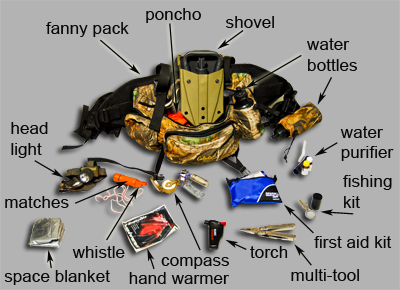Survival Kit
 Many hunters put together a survival kit and carry it with them whenever they hunt, especially in remote areas. Another precaution to take is never hunt alone. The “buddy system” can be advantageous in any emergency. Some of the things to include are:
Many hunters put together a survival kit and carry it with them whenever they hunt, especially in remote areas. Another precaution to take is never hunt alone. The “buddy system” can be advantageous in any emergency. Some of the things to include are:
- 2 Compasses - If lost, you might doubt one, so check them together
- Topographical map of the area you are hunting.
- GPS device and extra batteries
- Cell phone or personal distress beacon
- Signaling device - a mirror or CD
- Whistle
- Flashlight or headlight and spare bulbs and batteries
- Fire starters - waterproof matches, butane lighter, metal match and striker
- Knife
- Thermal foil blanket - or space blanket
- Water
- Water purification device
- Metal cup
- Fishing kit
- Poncho
- Food - high energy (chocolate) and protein (jerky)
- Pliers
- Insect repellant
- Sun block
- 30 feet of nylon cord
- 6 foot sheet of clear plastic
- Bootlaces
- Bandana
- Small coil of wire
- Folding Saw
- Pencil and small pad of paper
- First Aid Kit
A First Aid Kit should contain:
- 2 inch square sterile gauze pads
- 4 inch square sterile gauze pads
- Sterile gauze bandage roll
- Soft-wrap bandage
- Adhesive bandages - various sizes
- Antibiotic ointment
- Antihistamines
- Aspirin
- Antacid
- Chemical cold packs
- Chemical hot packs
- Tweezers
- Needles
- Latex gloves
- Routine medications if taking any
Other items:
CPR breathing barrier
Automated External Defibrillator- AED- in the event of a sudden cardiac arrest, proper use of these units can save a life. There different types you can buy but they all have similar features and they all provide recorded voice prompts that guide you through its use.
Again, it is the hunter's responsibility to attend a Certified First-Aid and CPR Course (American Heart Association or Red Cross).